This was published 1 year ago
Mindful travel, Japan: A guide to relaxing onsens, food, accommodation and nature
By Julietta Jameson
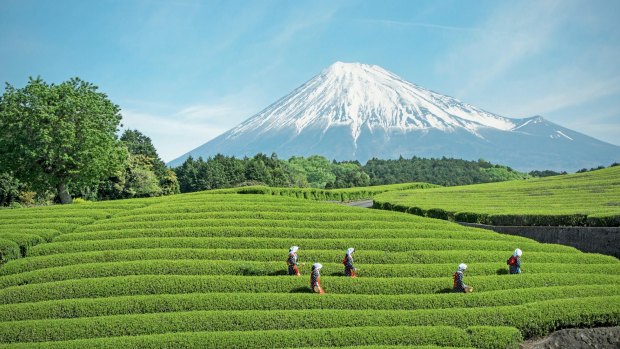
Tea rituals form an important part of Japanese tradition. Pictured: Tea harvest in the province of Shizuoka.
We wake to the smell of green tea, grilled fish and the scent of wood and tatami. The morning light throws shadows on the shoji screens of our ryokan room.
Our breakfast is booked for 8am so we float out of bed, put on our yukata (robe), tabi (socks) and zori (sandals) and make our way along the long, narrow corridor to the breakfast room. Tiny snowflakes drift lazily from the sky and ice clings to the windows, although the day looks bright and clear.
Our waiter appears with a pot of hojicha (tea) and small glasses of local apple juice (the Yudanaka area is famous for its apples). Artful dishes appear at our table – mountain vegetables, a perfectly cooked egg, grilled fish, pickles and rice, and a tiny dish of yoghurt and fresh fruit.
It looks almost as if there is too much food but each dish is perfectly portioned and complements the next.
We plan our day over breakfast, making sure we leave spaces in-between, a Japanese philosophy called "ma" that we always like to build into our travel – Japan has taught us how we would like to live in the world.
Understanding contemporary Japan lies in finding the essence of ancient Japanese culture by travelling to small communities and walking and cycling around the backstreets. It's about stopping for chance connections and trying to live like a local.
What has gone before defines and shapes the present in Japan. Bold graphic prints on kimono reflect updated modernism. The design of a robot could be shaped by Zen philosophy. What might look to the Western eye unfinished or unobserved is a meticulously thought-out idea.
Japan celebrates a culture that reveres moon viewing, marks the changing of the seasons with festivities, eats seasonally and has unbelievable nature, from shinrin yoku (forest bathing) to towns and cities with beautiful green spaces and immaculately kept gardens.
Trains are fast and efficient, communal onsen (hot springs) and sento (regular water bath) bathing is affordable and relaxing to all, and pilgrimage paths that were tramped centuries ago are still being walked today. Silence is in the everyday. Calm is in the rapidly beating hearts of the cities. This is the way of things in Japan.
Here, then, is our guide, for when Japan finally re-embraces the world's travellers (and it surely can't be much longer) for mastering the true art of Japanese mindfulness.
MINDFUL BATHING
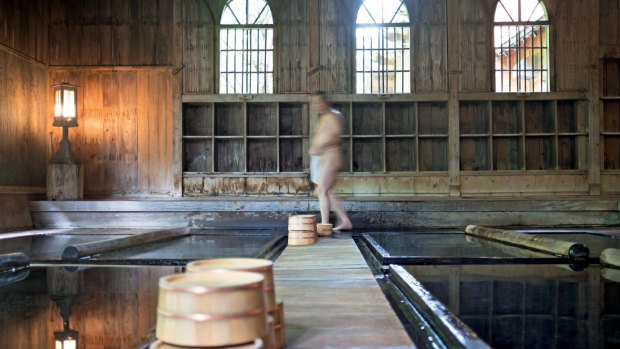
Discard both your clothes and daily cares and enjoy a time-honoured bathing ritual in one of Japan's 3000 hot springs. Onsen have been revered for centuries for their relaxing and healing qualities.
Communal naked bathing can be a sacred ritual, a form of deep relaxation and a way to relieve ailments.
It's not an exclusive day spa – it's an affordable, social experience, an outing where family or friends can enjoy each other's company and engage in 'hadaka no tsukiai', or 'naked communication'. Everyone is equal in the bath and conversations – deep or casual – can be had while in a relaxed state.
Can there be anything more mindful than steeping in hot water, soaking and meditating while you gaze upon snow-kissed mountains, verdant forest glades or fields aglow with bright summer flowers?
As an added bonus, most onsen and super sento will feature all the best health and wellbeing treatments, including relaxation rooms, saunas, massage, reflexology and more.
Where to experience it
HOSHI ONSEN, CHOJUKAN
Hoshi Onsen is one of 10 "secret" onsens of Japan, hidden in the green depths of the Joshinetsu Kogen National Park. If you want to discover a deeper omotenashi (Japanese hospitality), you've come to the right place. Hoshi no yu is 140 years old, a Meiji-period (1868 to 1912) onsen featuring a grid of baths bordered by wood, languishing under a breathtaking vaulted wooden ceiling. It's a mixed bath, the separate men's and women's changing rooms lead into the central room. The rare water here bubbles up from the gaps in the stones, caressing you with rich minerals. See hoshi-onsen.com
MINDFUL FLAVOURS
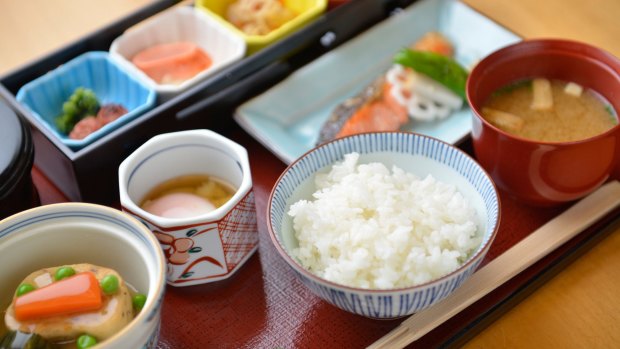
Chado (the tea ceremony, or the way of tea), along with Kodo (the way of incense), and Kado (the way of flowers), are considered the three classical refined arts in Japan.
The architecture of a chashitsu (teahouse) is a lesson in simplicity. How you enter, the position you sit in and the view – all are considered.
Tea has become an essential part of our travel while in Japan. It presses pause on the day, giving us space to reflect and relax. Japanese tea will be served in many of the places you will visit, eat or stay, and is an important way for a host to share their kindness with you.
The Japanese know how to imbue even the humblest food with a sense of occasion. You can be in a high-end sushi restaurant sampling delicate morsels a la carte or in a ryokan enjoying a kaiseki banquet, on a train eating a bento box or eating a tasty ramen in a standing bar surrounded by slurping salarymen – no matter what or where you experience, you'll be imprinting a lasting food memory.
Where to experience it
TOKO-AN AT IMPERIAL HOTEL, TOKYO
The Imperial, one of Tokyo's most revered hotels, surprisingly features a perfectly realised re-creation of a traditional sukiya-zukuri style teahouse with a classic three-chambered structure on its fourth floor. It is designed to take you out of the everyday and to a more refined, sophisticated world, like that of a classical teahouse in the deep countryside rather than in urban Tokyo. See imperialhotel.co.jp
MINDFUL STAYS
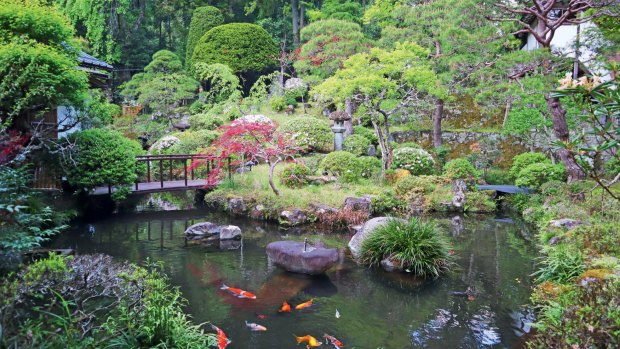
From spiritually enriching temple stays to time-honoured ryokan with onsen, off-the-grid sustainable lodgings and forested mountain retreats, Japan is a treasure-trove of considered and elevated accommodation.
One experience you should not miss is staying in a ryokan. The oldest recorded ryokan are Nishiyama Onsen Keiunkan in Hayakawa (705 CE), recognised as the oldest hotel in the world, and Hoshi Ryokan in Komatsu (718 CE).
Designed as rest stops for weary samurai and merchants, their sole purpose is to provide hospitality, regional cooking, a relaxing environment, a bath (usually hot springs) and a cosy night's sleep.
Wherever you stay, buy some bath salts, a face mask and some pampering products (we always buy foot cream) and have at least one cosy night in.
Japan has an estimated 80,000 Buddhist temples, and many act as peaceful meditation retreats. From mountainous hideaways and secretive forest compounds to serene escapes near major city hubs, some of our most life-affirming experiences in Japan have been overnight stays at Buddhist temples.
So, turn off your tech, prepare for a holiday from your usual self and submit to the life of a monk, limiting your spoken word, eating cleanly and spending time in quiet meditation.
How to experience it
KAKURINBO SHUKUBO, MINOBU, YAMANASHI
Kakurinbo Shukubo is set in Gyogakuin sub-temple in the grounds of Kuonji Temple on land that has been home to the Nichiren Shu sect of Buddhism since the late 1200s. Historic rooms with wooden ceilings and delicately painted screens are magical in the half light of the afternoon or early morning. Kakurinbo specialises in kaiseki banquets that feature yuba (tofu skin) and fresh local vegetables that will make you rethink your regular diet. Early morning prayers will clear your mind and help you ponder the deep beauty of the temple grounds which include a famous garden (with koi pond) designed by poet and Zen master Muso Kokushi in the early 1300s. Yoga and sutra copying can be enjoyed surrounded by nature. For those perfect photographs in the beautiful grounds, Kakurinbo dress you in formal kimono. See kakurinbo.com
MINDFUL GREENERY
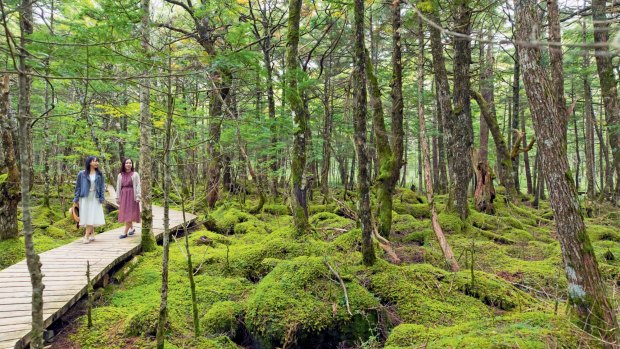
Built by emperors, monks and samurai, Japanese gardens have been revered by all classes of people for generations.
Japanese gardens follow the wabi-sabi principle of perfection in imperfection. Your path will be winding, never straight. A leaf flutters to the ground landing on a raked dry garden. The ageing and patina of bark on trees.
The mismatched cobbled bridge that spans a winding river. Notable elements recur in Japanese gardens, including water features (lakes, ponds and waterfalls), bridges, stepping stones and small islands.
Beautiful, colourful koi (brocaded carp) school in impressive numbers in waterways, drawing gasps from onlookers. Common plantings include cherry and plum blossoms, maples, gingko trees, conifers, hydrangeas, wisteria, peonies, waterlilies and ferns, all positioned carefully to enhance their beauty and planted en-masse for the most dramatic effect.
The term shinrin yoku, or forest bathing, was created as recently as 1980 by the Japanese Ministry of Agriculture, Forestry and Fisheries in recognition that many Japanese people needed access to nature to escape the negative impact of spending too much time in the big cities. In the height of summer many Japanese people head to the forest instead of the beach.
Like a swim in the ocean or a soak in an onsen, bathing in natural forested surrounds relaxes you – helps you absorb positivity and release negativity. Switching off your tech for the day allows for a complete retooling of your attitude.
How to experience it
KOKENOMORI (MOSS FOREST), NAGANO
Surrounding Shirakoma Pond, Kokenomori (Moss Forest) sits in Nagano prefecture's Eastern Mountain range, in the lush glades reclining between Mount Aka and Mount Morai. The area's climate sees regular rainfall which, in turn, over centuries, has given rise to a dreamy moss forest. The light falls differently here, filtering through the trees, illuminating the luxurious carpet of green which sparkles with tiny diamonds of dew. The forest trail around the peaceful pond takes about 35 minutes. There are over 480 species of moss in the forest, each having its own shape, texture and personality. Tread softly and notice each step. See pref.nagano.lg.jp
MINDFUL TRAILS
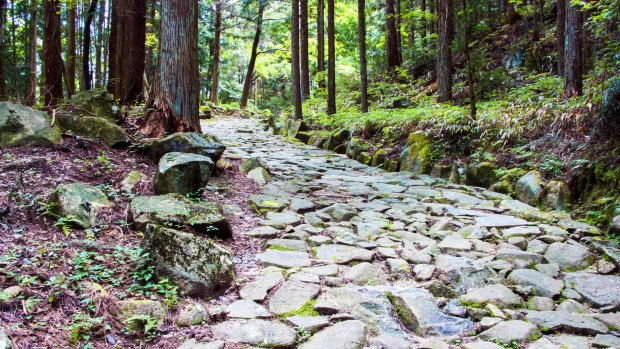
Japan boasts some of the world's most astounding geography. Rugged, unbridled natural landscapes feature dense forests and waterfalls, making for some of the most memorable trails for the serious hiker or the novice woodland walker. We've trekked through the snow to watch monkeys bathing in hot springs, walked to outdoor onsen in midsummer, and witnessed the unbelievable autumn and spring colour in multiple forest walks.
One such place is Sankeien Garden, built by silk trader Hara Sankei in the late 1800s and early 1900s. It's one of Japan's most impressive strolling gardens and testament to Yokohama's power as a trading port.
The vast space, stretching along the coast, is known for cherry blossom viewing and verdant natural trails that take you out of city life and imbue you with a feeling that you are walking in country Japan or in Kyoto's hallowed, sacred groves.
The grounds feature several buildings of note, "imported" from various places around Japan, including the three-tiered pagoda from Tomyoji Temple in Kyoto (which rises majestically above the trees).
The gashho-style farmhouse of the Yanohara family is also one of the garden's standout treasures, but much more can be unveiled by strolling the grounds without any particular aim or direction – it's one of Sankeien garden's particular joys. See sankeien.or.jp
How to experience it
NAKASENDO WAY, TOKYO TO KYOTO
The Nakasendo (central mountain) Way is a postal route shaped in the 8th century and once linked Old Edo (Tokyo) to Kyoto. Several parts of the trail remain in their original form, most notably the trail through the Kiso Valley leading toward Magome-juku (preserved postal town), the 43rd of the 69 stations. Many minshuku (family-run bed and breakfasts) dot the way and are recommended for authentic overnight stays and making connections with locals. A historical pilgrimage rather than a spiritual one, the Nakasendo Way offers the mindful traveller a chance to hop into a time machine and explore nature and life as it was in slower and gentler time. See nakasendoway.com
This is an edited extract from Mindfulness Travel Japan: Nature, Food, Forest Bathing, Tea Ceremonies, Onsen, Craft & Meditation by Steve Wide and Michelle Mackintosh, published by Hardie Grant Explore, RRP $29.99, available in-stores nationally on May 4. See hardiegrant.com
FIVE MINDFUL CREATIVE EXPERIENCES
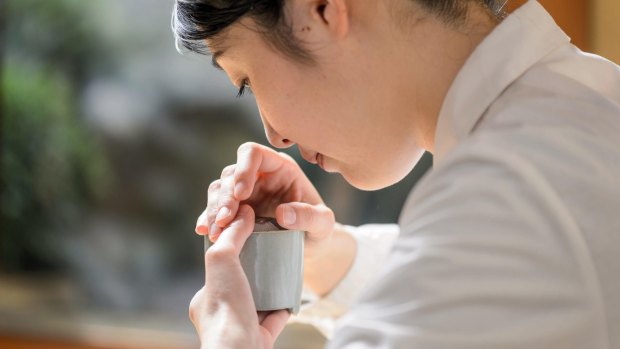
INCENSE CLASSES
Dating back 200 years, Kyoto's Yamada-Matsu started out as a pharmacy that sold quality wood and raw ingredients for making incense. It holds three styles of Monko (the art of enjoying incense) workshops. Learn how to "listen to the fragrance". Make scented sachets or learn how to make kneaded incense by fashioning powder with special syrup. Workshops run between 50 and 60 minutes. See yamadamatsu.co.jp/en
CALLIGRAPHY
Calligraphy classes are held in the grounds of Kyoto's Taizoin Zen temple which dates back to 1404 CE. A monk describes the history of calligraphy before teaching you how to master the fearless strokes of bokuseki (Zen-infused calligraphy) that transports Kanji to a divine plain. The lesson takes 90 minutes. See taizoin.com
IKEBANA
Ikebana combines the spiritual teachings of Buddhism with the careful placement of bud, branch and stem. It's a meditation on form, presenting the fragility of nature in a precious tableau. Learn the art at the birthplace of Ikebana, Ikenobo at Rokkakudo, an atmospheric temple in the back streets of Kyoto dating back 1,400 years. The two-hour classes are on Thursdays at 1.30 pm. See ikenobo.jp/English
PAPERMAKING
In picture perfect Washi-no-Sato (Echizen Washi Village), Udatsu Paper and Craft Museum, northwest of Nagoya, is a 1748 papermaker's house with an extensive display of the washi paper made in the village's 67 paper mills. It hosts paper making courses using traditional techniques. Learn about hosho (wrapping paper), gasenshi (calligraphy paper) and other specialty paper forms. See echizenwashi.jp
POTTERY
A three-hour bus trip from Tokyo on the "pottery line", Mashiko is one of Japan's most revered pottery towns. Mayu and Issei Furuki run a minshuku (bed and breakfast) in a 300-year-old farmhouse with its own kiln. Small English-friendly pottery classes go for 90 minutes, three hours (morning or afternoon) or a full day and are held in a rustic barn with pottery wheels lined up for novice creatives. See mashiko-tourism.com
Sign up for the Traveller Deals newsletter
Get exclusive travel deals delivered straight to your inbox. Sign up now.